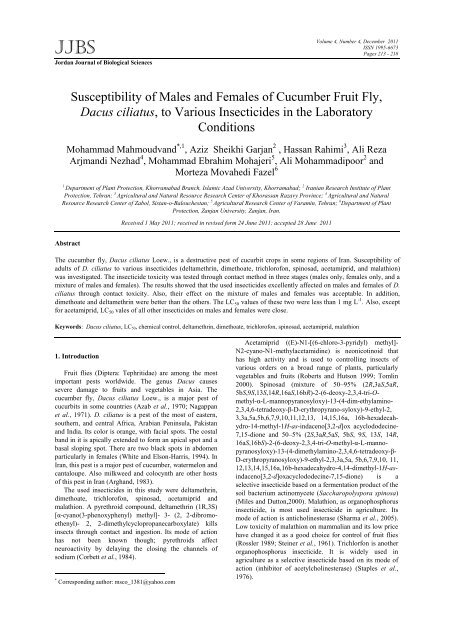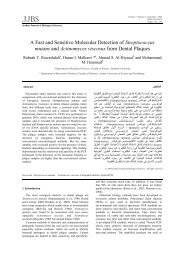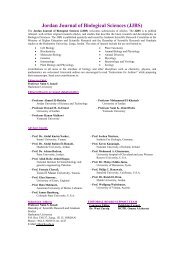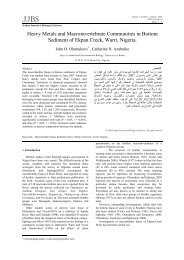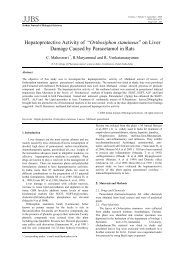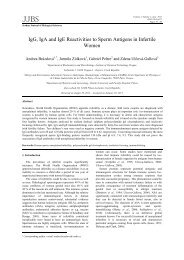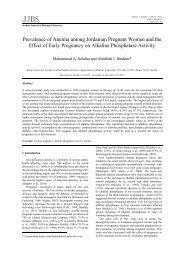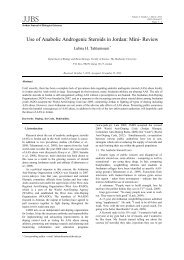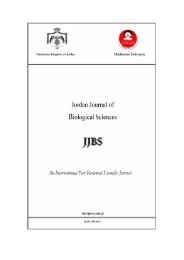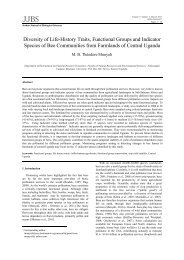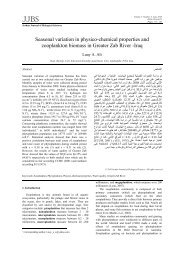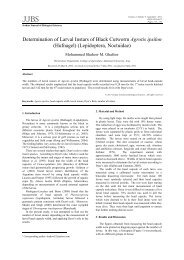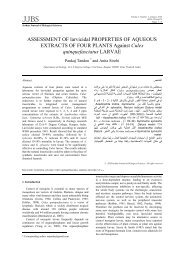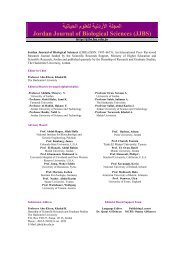Dacus ciliatus - Jordan Journal of Biological Sciences
Dacus ciliatus - Jordan Journal of Biological Sciences
Dacus ciliatus - Jordan Journal of Biological Sciences
You also want an ePaper? Increase the reach of your titles
YUMPU automatically turns print PDFs into web optimized ePapers that Google loves.
JJBS<br />
<strong>Jordan</strong> <strong>Journal</strong> <strong>of</strong> <strong>Biological</strong> <strong>Sciences</strong><br />
Volume 4, Number 4, December 2011<br />
ISSN 1995-6673<br />
Pages 213 - 218<br />
Susceptibility <strong>of</strong> Males and Females <strong>of</strong> Cucumber Fruit Fly,<br />
<strong>Dacus</strong> <strong>ciliatus</strong>, to Various Insecticides in the Laboratory<br />
Conditions<br />
Mohammad Mahmoudvand *,1 , Aziz Sheikhi Garjan 2 , Hassan Rahimi 3 , Ali Reza<br />
Arjmandi Nezhad 4 , Mohammad Ebrahim Mohajeri 5 , Ali Mohammadipoor 2 and<br />
Morteza Movahedi Fazel 6<br />
1 Department <strong>of</strong> Plant Protection, Khorramabad Branch, Islamic Azad University, Khorramabad; 2 Iranian Research Institute <strong>of</strong> Plant<br />
Protection, Tehran; 3 Agricultural and Natural Resource Research Center <strong>of</strong> Khorassan Razavy Province; 4 Agricultural and Natural<br />
Resource Research Center <strong>of</strong> Zabol, Sistan-o-Balouchestan; 5 Agricultural Research Center <strong>of</strong> Varamin, Tehran; 6 Department <strong>of</strong> Plant<br />
Protection, Zanjan University, Zanjan, Iran.<br />
Abstract<br />
Received 1 May 2011; received in revised form 24 June 2011; accepted 28 June 2011<br />
The cucumber fly, <strong>Dacus</strong> <strong>ciliatus</strong> Loew., is a destructive pest <strong>of</strong> cucurbit crops in some regions <strong>of</strong> Iran. Susceptibility <strong>of</strong><br />
adults <strong>of</strong> D. <strong>ciliatus</strong> to various insecticides (deltamethrin, dimethoate, trichlor<strong>of</strong>on, spinosad, acetamiprid, and malathion)<br />
was investigated. The insecticide toxicity was tested through contact method in three stages (males only, females only, and a<br />
mixture <strong>of</strong> males and females). The results showed that the used insecticides excellently affected on males and females <strong>of</strong> D.<br />
<strong>ciliatus</strong> through contact toxicity. Also, their effect on the mixture <strong>of</strong> males and females was acceptable. In addition,<br />
dimethoate and deltamethrin were better than the others. The LC 50 values <strong>of</strong> these two were less than 1 mg L -1 . Also, except<br />
for acetamiprid, LC 50 vales <strong>of</strong> all other insecticides on males and females were close.<br />
Keywords: <strong>Dacus</strong> <strong>ciliatus</strong>, LC50, chemical control, deltamethrin, dimethoate, trichlor<strong>of</strong>on, spinosad, acetamiprid, malathion<br />
1. Introduction *<br />
Fruit flies (Diptera: Tephritidae) are among the most<br />
important pests worldwide. The genus <strong>Dacus</strong> causes<br />
severe damage to fruits and vegetables in Asia. The<br />
cucumber fly, <strong>Dacus</strong> <strong>ciliatus</strong> Loew., is a major pest <strong>of</strong><br />
cucurbits in some countries (Azab et al., 1970; Nagappan<br />
et al., 1971). D. <strong>ciliatus</strong> is a pest <strong>of</strong> the most <strong>of</strong> eastern,<br />
southern, and central Africa, Arabian Peninsula, Pakistan<br />
and India. Its color is orange, with facial spots. The costal<br />
band in it is apically extended to form an apical spot and a<br />
basal sloping spot. There are two black spots in abdomen<br />
particularly in females (White and Elson-Harris, 1994). In<br />
Iran, this pest is a major pest <strong>of</strong> cucumber, watermelon and<br />
cantaloupe. Also milkweed and colocynth are other hosts<br />
<strong>of</strong> this pest in Iran (Arghand, 1983).<br />
The used insecticides in this study were deltamethrin,<br />
dimethoate, trichlor<strong>of</strong>on, spinosad, acetamiprid and<br />
malathion. A pyrethroid compound, deltamethrin (1R,3S)<br />
[α-cyano(3-phenoxyphenyl) methyl]- 3- (2, 2-dibromoethenyl)-<br />
2, 2-dimethylcyclopropanecarboxylate) kills<br />
insects through contact and ingestion. Its mode <strong>of</strong> action<br />
has not been known though; pyrethroids affect<br />
neuroactivity by delaying the closing the channels <strong>of</strong><br />
sodium (Corbett et al., 1984).<br />
* Corresponding author: msco_1381@yahoo.com<br />
Acetamiprid ((E)-N1-[(6-chloro-3-pyridyl) methyl]-<br />
N2-cyano-N1-methylacetamidine) is neonicotinoid that<br />
has high activity and is used to controlling insects <strong>of</strong><br />
various orders on a broad range <strong>of</strong> plants, particularly<br />
vegetables and fruits (Roberts and Hutson 1999; Tomlin<br />
2000). Spinosad (mixture <strong>of</strong> 50–95% (2R,3aS,5aR,<br />
5bS,9S,13S,14R,16aS,16bR)-2-(6-deoxy-2,3,4-tri-Omethyl-α-L-mannopyranosyloxy)-13-(4-dim-ethylamino-<br />
2,3,4,6-tetradeoxy-β-D-erythropyrano-syloxy)-9-ethyl-2,<br />
3,3a,5a,5b,6,7,9,10,11,12,13, 14,15,16a, 16b-hexadecah-<br />
ydro-14-methyl-1H-as-indaceno[3,2-d]ox acyclododecine-<br />
7,15-dione and 50–5% (2S,3aR,5aS, 5bS, 9S, 13S, 14R,<br />
16aS,16bS)-2-(6-deoxy-2,3,4-tri-O-methyl-α-L-mannopyranosyloxy)-13-(4-dimethylamino-2,3,4,6-tetradeoxy-β-<br />
D-erythropyranosyloxy)-9-ethyl-2,3,3a,5a, 5b,6,7,9,10, 11,<br />
12,13,14,15,16a,16b-hexadecahydro-4,14-dimethyl-1H-asindaceno[3,2-d]oxacyclododecine-7,15-dione)<br />
is a<br />
selective insecticide based on a fermentation product <strong>of</strong> the<br />
soil bacterium actinomycete (Saccharopolyspora spinosa)<br />
(Miles and Dutton,2000). Malathion, as organophosphorus<br />
insecticide, is most used insecticide in agriculture. Its<br />
mode <strong>of</strong> action is anticholinesterase (Sharma et al., 2005).<br />
Low toxicity <strong>of</strong> malathion on mammalian and its low price<br />
have changed it as a good choice for control <strong>of</strong> fruit flies<br />
(Rossler 1989; Steiner et al., 1961). Trichlorfon is another<br />
organophosphorus insecticide. It is widely used in<br />
agriculture as a selective insecticide based on its mode <strong>of</strong><br />
action (inhibitor <strong>of</strong> acetylcholinesterase) (Staples et al.,<br />
1976).
214<br />
© 2011<strong>Jordan</strong> <strong>Journal</strong> <strong>of</strong> <strong>Biological</strong> <strong>Sciences</strong>. All rights reserved - Volume 4, Number 4<br />
The fruit fly D. <strong>ciliatus</strong> is important in Iran and it is a<br />
major pest in many provinces <strong>of</strong> Iran. The main method<br />
for controlling this pest and other fruit flies is chemical<br />
control in Iran. Therefore, applying the effective<br />
insecticide for this method can be efficient and useful. In<br />
this study, we investigated the contact effect <strong>of</strong> various<br />
insecticides (deltamethrin, dimethoate, trichlor<strong>of</strong>on,<br />
spinosad, acetamiprid, and malathion) on D. <strong>ciliatus</strong> in<br />
three stages (effect on males, on females, and on a<br />
combination <strong>of</strong> males and females). LC 50 values <strong>of</strong> these<br />
insecticides were calculated separately.<br />
2. Materials and Methods<br />
2.1. Insect stock<br />
<strong>Dacus</strong> <strong>ciliatus</strong> colony was collected from<br />
cucumber fields <strong>of</strong> Varamin in the east <strong>of</strong> Tehran, Iran in<br />
early October <strong>of</strong> 2008. For this, the infested small<br />
cucumbers, Cucumis sativus, having larvae <strong>of</strong> this pest,<br />
were collected and transferred to laboratory. The<br />
cucumbers were placed in the trays (1×1m) with their<br />
bottoms covered by loam soil, 1cm in thickness, until<br />
leaving the larvae. For preventing the escape <strong>of</strong> the adults,<br />
the trays were covered by plastic cages, too. A sugar<br />
solution (10%) was used for feeding the adults in the<br />
cages. Insect rearing and all bioassay tests were performed<br />
at 25 ± 2 °C and 65 ± 5% relative humidity under a 12:12<br />
(L:D) photoperiod in the growth chamber.<br />
2.2. Insecticides<br />
The formulated insecticides, used in the present study,<br />
were spinosad [Tracer 240 SC (AI)] deltamethrin [Decis<br />
2.5% EC (AI)], dimethoate [40% EC (AI)], trichlor<strong>of</strong>on<br />
[Diptrix 80% SP (AI)], acetamiprid [Mospilan 20% SP<br />
(AI)], and malathion [50% EC (AI)].<br />
2.3. Bioassay tests<br />
The bioassay tests <strong>of</strong> this study were performed in three<br />
sections (Bioassay on males only, on females only, and on<br />
a mixture <strong>of</strong> males and females). For bioassay tests, the<br />
contact toxicity was used. All concentrations <strong>of</strong><br />
insecticides were prepared in water. As a control, water<br />
was used. For bioassays, Petri dishes (9 cm in diameter)<br />
were sprayed with various concentrations <strong>of</strong> insecticides,<br />
and, then, they were permitted to dry at room temperature<br />
for 2 h. Ten 5 day-old adult insects were placed in each<br />
Petri dish after catching by aspirator. In the test on mixture<br />
sexes, 5 individuals were selected from each sex. A sugar<br />
solution (10%) was used to feed the insects. These tests<br />
were repeated 4 times. Mortality was recorded 24 h after<br />
treatment. The data were analyzed by Proc Probit using<br />
SAS s<strong>of</strong>tware (SAS Institute 1997). This method for all<br />
tests was alike.<br />
3. Results<br />
3.1. Toxicity on males<br />
Table 1 shows the values <strong>of</strong> LC 50 <strong>of</strong> various<br />
insecticides on males <strong>of</strong> the cucumber fly. Values <strong>of</strong> LC 50<br />
<strong>of</strong> tested deltamethrin, dimethoate and trichlorfon were<br />
0.39, 0.24 and 1.57 mg L -1 , respectively. LC 50 values <strong>of</strong><br />
spinosad, acetamiprid and malathion were 8.03, 6.87 and<br />
2.28 mg L -1 , too. Results <strong>of</strong> bioassay showed that the<br />
dimethoate LC 50 was the lowest compared to others. On<br />
the other hand, the susceptibility to spinosad was lower<br />
than others. Toxicity ratio <strong>of</strong> dimethoate on males was<br />
1.62, 6.54, 33.45, 28.65 and 9.5 folds higher than<br />
deltamethrin, trichlorfon, spinosad, acetamiprid and<br />
malathion, respectively.<br />
3.2. Toxicity on females<br />
In table 2, the effects <strong>of</strong> the mentioned insecticides on<br />
females <strong>of</strong> cucumber fly are shown. Values <strong>of</strong> LC 50 <strong>of</strong><br />
deltamethrin, dimethoate, trichlorfon, spinosad,<br />
acetamiprid and malathion on D. <strong>ciliatus</strong> females were<br />
0.52, 0.4, 2.4, 8.52, 19.88 and 3.57 mg L -1 . The toxicity <strong>of</strong><br />
dimethoate on females was the highest compared to others.<br />
It was 0.76, 6, 21.3, 49.7 and 8.92 folds higher than<br />
deltamethrin, trichlorfon, spinosad, acetamiprid and<br />
malathion. It is clear that toxicity <strong>of</strong> acetamiprid is the<br />
lowest on females. Also, comparing the toxicity <strong>of</strong> these<br />
insecticides on males and females is shown in fig. 1.<br />
Figure 1 shows that males <strong>of</strong> D. <strong>ciliatus</strong> were more<br />
susceptible than females. This difference was clearer in<br />
acetamiprid.<br />
3.3. Effect on mixture <strong>of</strong> males and females<br />
Table 3 displays the effect <strong>of</strong> insecticides on mixture <strong>of</strong><br />
50% males: 50% females <strong>of</strong> D. <strong>ciliatus</strong>. Similar to the<br />
results <strong>of</strong> table 2, the highest susceptibility <strong>of</strong> adults was<br />
showed in dimethoate compared to others (table 3). LC 50<br />
values <strong>of</strong> deltamethrin, dimethoate, trichlorfon, spinosad,<br />
acetamiprid and malathion on adults were 0.45, 0.28, 1.95,<br />
8.20, 11.50 and 2.85 mg L -1 , respectively; their lowest<br />
toxicity was seen in acetamiprid.<br />
4. Discussion<br />
In this study, the effectiveness <strong>of</strong> various insecticides<br />
belonging to organophosphorus, pyrethroids, biorationals<br />
and neonicotinoides (deltamethrin, dimethoate,<br />
trichlor<strong>of</strong>on, spinosad, acetamiprid and malathion) on<br />
male, female and both sexes <strong>of</strong> D. <strong>ciliatus</strong> was<br />
investigated. Aetamiprid was selected because <strong>of</strong> its safe<br />
effect on human beings and trichlor<strong>of</strong>on due to its<br />
selectivity on Diptera. This is the first research on the<br />
toxicity <strong>of</strong> these insecticides to investigate D. <strong>ciliatus</strong>;<br />
hence, the results were compared with the results on other<br />
insects.<br />
Our results showed that dimethoate had the lowest<br />
toxicity on males, females, and both males and females.<br />
On the other hand, LC 50 values <strong>of</strong> spinosad and<br />
acetamiprid were higher than the others. Also a pyrethroid<br />
insecticide, deltamethrin, has a good toxicity on this pest<br />
compared to malathion. Similar to this, Malakov et al.<br />
(2001) reported that toxicity <strong>of</strong> a pyrethroid insecticide<br />
(fenpropathrin) was higher than malathion. Using broad<br />
spectrum insecticides causes adverse effects on natural<br />
enemies, natural resource and human health. Also,<br />
secondary pest outbreaks in this condition (Emden and<br />
Peakall 1996). Hence, replacing these compounds with<br />
low side effect insecticides such as spinosad might be<br />
important. Vargas et al. (2003) stated that spinosad is a<br />
good replacement for DDVP and naled for killing the male<br />
oriental fruit flies and melon flies (Dipter: Tephritidae).
Deltamethrin<br />
Dimethoate<br />
Trichlorfon<br />
Spinosad<br />
Acetamiprid<br />
Malathion<br />
Deltamethrin<br />
Dimethoate<br />
Trichlorfon<br />
Spinosad<br />
Acetamiprid<br />
Malathion<br />
© 2011<strong>Jordan</strong> <strong>Journal</strong> <strong>of</strong> <strong>Biological</strong> <strong>Sciences</strong>. All rights reserved - Volume 4, Number 4<br />
Table 1. Susceptibility <strong>of</strong> <strong>Dacus</strong> <strong>ciliatus</strong> males exposed to various insecticides in the laboratory conditions<br />
n a df LC50<br />
(mg L -1 )<br />
300<br />
300<br />
300<br />
300<br />
300<br />
300<br />
6<br />
4<br />
5<br />
4<br />
4<br />
4<br />
0.39 (0.29-0.55)<br />
0.24 (0.13-0.28)<br />
1.57 (1.32-1.85)<br />
8.03 (2.94-11.64)<br />
6.87 (3.31-11.07)<br />
2.28 (0.90-3.27)<br />
Slope ± SE χ 2 Toxicity Ratio<br />
1.58 ± 0.23<br />
1.82 ± 0.28<br />
1.89 ± 0.15<br />
3.26 ± 1.26<br />
1.5 ± 0.33<br />
3.79 ± 1.3<br />
n a : number <strong>of</strong> subjects<br />
3.32<br />
1.09<br />
4.2<br />
2.04<br />
0.65<br />
2.2<br />
1.62<br />
1<br />
6.54<br />
33.45<br />
28.65<br />
9.5<br />
Table 2. Susceptibility <strong>of</strong> females <strong>of</strong> <strong>Dacus</strong> <strong>ciliatus</strong> exposed to various insecticides in the laboratory conditions<br />
n a df LC50<br />
(mg L -1 )<br />
300<br />
300<br />
300<br />
300<br />
300<br />
300<br />
6<br />
4<br />
5<br />
4<br />
4<br />
4<br />
0.52 (0.38-0.75)<br />
0.4 (0.25-0.53)<br />
2.4 (2.02-2.80)<br />
8.52 (1.46-12.26)<br />
19.88 (7.30-12.10)<br />
3.57 (1.87-6.24)<br />
Slope ± SE χ 2 Toxicity Ratio<br />
1.48 ± 0.22<br />
1.89 ± 0.41<br />
2 ± 0.17<br />
3.69 ± 1.58<br />
2.8 ± 0.75<br />
2. 9 ± 1.18<br />
n a : number <strong>of</strong> subjects<br />
2.8<br />
1.1<br />
2.4<br />
1.9<br />
0.74<br />
2.61<br />
0.76<br />
1<br />
6<br />
21.3<br />
49.7<br />
8.92<br />
Table 3. Susceptibility <strong>of</strong> mixture <strong>of</strong> males and females <strong>of</strong> <strong>Dacus</strong> <strong>ciliatus</strong> exposed to various insecticides in the laboratory conditions<br />
Deltamethrin<br />
Dimethoate<br />
Trichlorfon<br />
Spinosad<br />
Acetamiprid<br />
Malathion<br />
n a df LC50<br />
(mg L -1 )<br />
300<br />
300<br />
300<br />
300<br />
300<br />
300<br />
6<br />
4<br />
5<br />
4<br />
4<br />
4<br />
0.45 (0.36-0.57)<br />
0.28 (0.21-0.35)<br />
1.95 (1.72-2.18)<br />
8.20 (5.04-10.60)<br />
11.50 (7.34-15.76)<br />
2.85 (1.99-3.76)<br />
Slope ± SE χ 2 Toxicity Ratio<br />
1.51 ± 0.16<br />
1.71 ± 0.21<br />
1.92 ± 0.11<br />
3.45 ± 0.98<br />
1.76 ± 0.33<br />
3.18 ± 0.8<br />
n a : number <strong>of</strong> subjects<br />
3.7<br />
2.04<br />
5.44<br />
3.71<br />
2.3<br />
2.65<br />
1.6<br />
1<br />
6.94<br />
29.28<br />
41.07<br />
10.17<br />
215
216<br />
© 2011<strong>Jordan</strong> <strong>Journal</strong> <strong>of</strong> <strong>Biological</strong> <strong>Sciences</strong>. All rights reserved - Volume 4, Number 4<br />
Figure 1. Comparing LC50 values <strong>of</strong> various insecticides on mixture <strong>of</strong> males and females <strong>of</strong> <strong>Dacus</strong> <strong>ciliatus</strong> in the laboratory conditions.<br />
King and Hennessey (1996) underlined the effect <strong>of</strong><br />
spinosad on males and females <strong>of</strong> Caribbean fruit fly,<br />
Anastrepha suspense (Loew) (Diptera:Tephritidae) and<br />
reported that spinosad is a good candidate for controlling<br />
it. Barry et al. (2004) investigated the effect <strong>of</strong><br />
neonicotinoids (imidacloprid and acetamiprid) on a fruit<br />
fly, Rhagoletis mendex. They reported that acetamiprid,<br />
unlike imidacloprid, had no knock down property on that<br />
pest. Similar to this research, Olszak and Maciesiak (2004)<br />
found that acetamiprid had a good effect on blueberry<br />
maggot fly, Rhagoletis cerasi (Diptera: Tephritidae).<br />
Similar to the current results, Hu et al. (2000) stated that<br />
dimethoate is a good choice for controlling the females <strong>of</strong><br />
Rhagoletis pomonella (Diptera: Tephritidae). Khan and<br />
Khattak (2000) stated that trichlor<strong>of</strong>on and malathion<br />
decreased populations <strong>of</strong> melon fruit fly, Bactrocera<br />
cucurbitae (Coq) and muskmelon fruit fly, Cucumis melo<br />
(L.) compared to the untreated group.<br />
In Conclusion, the insecticides used in this study<br />
excellently affected males and females <strong>of</strong> D. ciliates; these<br />
insecticides can be useful for their chemical control.<br />
Among these insecticides, deltamethrin and dimethoate<br />
were better than others. The LC 50 values <strong>of</strong> these two were<br />
© 2011<strong>Jordan</strong> <strong>Journal</strong> <strong>of</strong> <strong>Biological</strong> <strong>Sciences</strong>. All rights reserved - Volume 4, Number 4<br />
Rossler Y. 1989. Insecticide Bait and cover sprays. In: Hooper<br />
ASR ( Eds.), Fruit Flies and their Biology Natural Enemies<br />
and Control. Elsevier Publishers, Amsterdam,The Netherlands,<br />
pp 329-335.<br />
SAS Institute. 1997. SAS/STAT. Guide for Personal<br />
Computers. Ver. 6.12. SAS Institute, Cary, NC.<br />
Sharma R, Bashir S, Irshad M, Nag T and Dogra TD. 2005.<br />
Dimethoate-induced effects on antioxidant status <strong>of</strong> liver and<br />
brain <strong>of</strong> rats following subchronic exposure. J Toxicol, 215:173-<br />
181.<br />
Staples RE, Kellem RG and Haseman JK. 1976. Developmental<br />
toxicity in the rat after ingestion <strong>of</strong> gavage <strong>of</strong> organophosphate<br />
pesticides (Dipterex, Imidan) during pregnancy. Environ Health<br />
Perspect, 30:133-140.<br />
Steiner LF, Rohwer GG, Ayers EL and Christenson LD. 1961.<br />
The role <strong>of</strong> attractants in the recent mediterranean fruit fly<br />
eradication in Florida. J Econ Entomol, 54:30-35.<br />
Tomlin CDS. 2000. The Pesticide Manual: A World<br />
Compendium. British Crop Protection Council, Surrey, UK.<br />
Vargas RI , Miller NW and Stark JD. 2003. Field trials <strong>of</strong><br />
spinosad as a replacement for naled, DDVP, and malathion in<br />
methyl eugenol and cue-lure bucket traps to attract and kill male<br />
oriental fruit flies and melon flies (Diptera: Tephritidae) in<br />
Hawaii. J Econ Entomol, 96: 1780-1785.<br />
White IM and Elson-Harris MM. 1994. Fruit Flies <strong>of</strong> Economic<br />
Significance: Their Identification and Bionomics. CAB<br />
International, Oxon, UK.<br />
217


